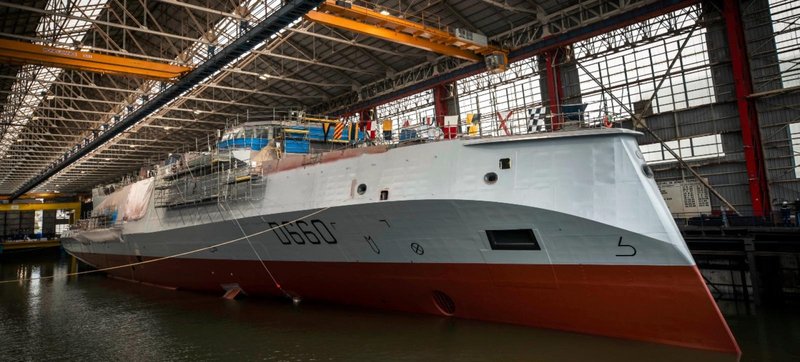Hard to foresee – why predictive maintenance for naval vessels may never be comprehensive
Thales UK’s recent £1.8 billion contract with the UK MoD to improve Royal Navy ship availability and resilience was unveiled just under a month after the collision between HMS Chiddingfold and HMS Bangor. The timing of this announcement covering predictive maintenance for the fleet is interesting, to say the least.
On 2 February, Thales UK announced it had been awarded a £1.8 billion Maritime Sensor Enhancement Team (MSET) contract by the UK MoD. MSET, according to the press release, ‘will sharpen the focus on equipment availability, predicting problems – through AI innovations and data management – rather than reacting when they emerge’... Continues below
Newsletter Sponsor:

Above: HMS Bangor seen in happier times. Could predictive maintenance have prevented the collision in Bahrain which damaged the ship? (Photo: UK MoD Crown Copyright)
The new contract, the release notes, is meant to address the RN’s need to increase its fleet’s availability in an era of increasing global instability.
Incidentally – and (un)fortunately? – this announcement came less than a month after HMS Chiddingfold, a Hunt-class mine countermeasures (MCM) vessel, struck HMS Bangor, a Sandown-class minehunter, as she was leaving the berth ahead of Bangor in Bahrain.
While Chiddingfold came out relatively unscathed, the other ship suffered significant damage. Her fate has yet to be determined, given that she was due to be decommissioned soon.
The RN has launched an inquiry, so details about the collision are still relatively few. Several sources, nevertheless, have indicated that the accident was likely caused by a mechanical breakdown in Chiddingfold’s propulsion control system. A pity, considering she was literally just out of major works on that system in Bahrain.

Schiebel – leading the unmanned evolution
So, considering the serviceability problems the RN has recently run into, what will the Thales contract bring?
In relation to the propulsion system specifically, nothing, as this has little to do with Thales’ business lines. But it will be crucial to considerably reducing the chances of anything like this (ie a system failure) happening to sonar, masts, periscopes and EW equipment currently fitted on RN assets – and provided by Thales.
So why only Thales hardware at this stage? Because MSET, which is effectively a form of predictive maintenance, relies on gathering data from various sensors to be able to constantly monitor specific systems’ health status.
If AI-assisted analysis of the data reveals that the system is not acting the way it should, it raises an alert before a failure might happen. And that data is proprietary.
This the main reason why predictive maintenance is currently done within navies on a largely ad-hoc basis. Sharing data from one’s system requires a whole raft of agreements, coordination and collaboration between industry partners and navies – including on cyber security – that take time to implement.
Other articles in this newsletter:
Is nowhere safe? Countering the threat to naval vessels at their home ports
Ready for action? Unpicking France’s plans for an armed UUV
The same is true for the French Navy and Naval Group. The company has designed the new FDI frigate with predictive maintenance in mind. The ships are fitted with a large number of sensors that gather data, which is subsequently collected by digitally integrated support centres that Naval Group develops for its clients.
The data is then inserted in the digital twin of the ship and processed to highlight potential issues with any of the systems. Similar solutions have been developed by Fincantieri and Navantia in Europe and Lockheed Martin in the US.

Above: Naval Group’s FDI frigate has predictive maintenance baked into its design, with multiple sensors sending proprietary data back to the shipbuilder. (Photo: Naval Group)
Implementing predictive maintenance is complex, which might also be why it is still more of an ad-hoc, industry-client endeavour than a fleet-wide initiative within a navy. Beyond sensor data and agreements on its sharing and fusion, this also requires development of new infrastructures capable of merging and processing that data.
While in France this was done by Naval Group, in the UK Thales will invest in waterfront facilities as part of the MSET contract.
Predictive maintenance also requires organisational changes to sustain the technical efforts and financial investments going into the digital transition.
The US Government Accountability Office (GAO), for instance, published a report in 2022 about the progress of predictive maintenance implementation across all three services of the US armed forces. The results were rather damning.
From the outset, in its summary, the report states that ‘while the military services have begun piloting predictive maintenance programmes on some weapon systems, they do not replace parts or components regularly based on predictive maintenance forecasts’.
The approach has been used successfully on a few systems. Yet the absence of a coherent implementation plan, including clear goals and metrics, to be able to measure the added value of the efforts is likely a barrier to motivation for crews. As a result, they do not seem to act systematically on the information they receive.
It is interesting, in fact, to note that the RN has worked (and may still be working) with BAE Systems on the Nelson initiative, a project designed to transform how the navy gains insights from its data. When searching for publicly available information on how the work is going, there did not seem to be any. This is not to say that it did not work, rather it shows that fleet-wide implementation of such efforts can be complicated.
Perhaps working with Thales on its sensors through MSET is a safer, more realistic way to begin improving fleet readiness.
Don't want to miss out on future Decisive Edge content? Make sure you are signed up to our email newsletters.











